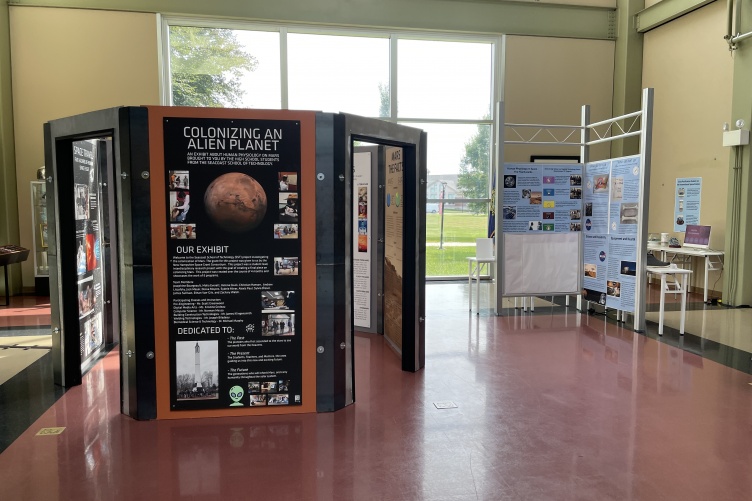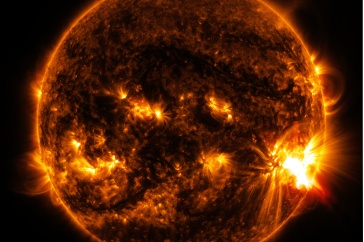
Students from two New Hampshire career and technical education centers learned a lot about space and perhaps even more about the importance of collaboration and relying on others during an unusual but enriching experience this year: They developed a museum exhibit about humans in space.
Juniors and seniors from the Seacoast School of Technology in Exeter and the Applied Technology Center in Milford worked tirelessly to research and develop numerous interactive displays for the McAuliffe-Shepard Discovery Center (MSDC) in Concord. The exhibit, titled “Human Physiology in Space,” draws from a wide spectrum of educational disciplines that all intertwine, including engineering, medicine, energy, water and agriculture. The N.H. Space Grant Consortium provided the funding for the exhibit, and numerous partners, educators and UNH scientists provided guidance for the students when needed.

The exhibit offers museum attendees the opportunity to learn about the effects of radiation on astronauts, build a miniature Mars colony and use touch-screen kiosks to watch the students’ presentations and run computer simulations about what it would take for humans to survive on the Red Planet.
“We’re always looking for new exhibits, especially those that explore missions to the moon and to Mars and humans living in space,” says Mirka Zapletal, Director of Education at the MSDC. “But our larger goal was for students to have a real-world experience, to work on an actual project for a client from start to finish, while thinking about how to make it interactive, fun and sturdy enough for children to use it. They did a really phenomenal job.”
Vasiliki Partinoudi ‘03G, director for the Milford Applied Technology Center worked closely with the center’s biotechnology teacher to make sure the project fit within the parameters of the school’s curriculum and competency requirements and attended “the big reveal” — the exhibit’s unveiling in July.
“It’s so exciting for a high school student to see their work in a museum, to see all their hard work on display,” Partinoudi says. “It’s rewarding to give high schoolers the opportunity to work on something that can be scaled up to experiments in space.”
Jennifer Bourgeault is a project director and the U.S. Country Coordinator for The GLOBE Program, a NASA-sponsored program where students around the world work together to collect environmental data and conduct research. Her work, based out of the UNH Earth Systems Research Center, involves collaboration with NASA employees whose positions require support from subject matter experts: engineers, journalists, welders, biologists, mathematicians, digital artists and many others. Bourgeault knows firsthand about the importance of teamwork to complete a project, and now so does her daughter — Josie Bourgeault, who is entering her senior year at the Seacoast School of Technology, was involved in developing part of the exhibit for the MSDC and along with other students from both schools had the opportunity to speak with NASA subject matter experts via Zoom.
"Part of the message that I've been getting from NASA is that they are trying to connect to the next generation and be role models for them, and this project with the MSDC and the two high schools really fit in with that goal."
“Part of the message that I’ve been getting from NASA is that they are trying to connect to the next generation and be role models for them, and this project with the MSDC and the two high schools really fit in with that goal,” Jennifer Bourgeault says.
The students were given wide latitude to create the final products for the exhibit, Zapletal says. She helped with logistics and connected the students with experts, including Andrew Jordan and Wouter de Wet, both research scientists in UNH’s Space Science Center. Other MSDC staff members held regular meetings with the students to check in on their progress and help them address obstacles — many of which happen in real life.
“Personally, I have always been a very independent worker, so having to work on this project with three other people forced me to be more open-minded to others’ ideas,” says Makayla Bobusia, an incoming senior at the Milford School of Applied Technology. “During the brainstorming stage was where this skill was most stimulated, but in the end I am very happy with the ideas we came up with.”
"Personally, I have always been a very independent worker, so having to work on this project with three other people forced me to be more open-minded to others' ideas."
Brianna Arnoldy, an incoming senior from the Milford Applied Technology School, says, “This project was quite different from others I’ve done in the past. I’ve never felt so creatively free with a project.” Perhaps not coincidentally, her grandfather, Roger Arnoldy, is a professor emeritus from UNH’s Space Science Center whose own research focused on rocket science.
Josie Bourgeault, who wants to be an engineer, observed that final product might not have ended up how it was originally intended, but with good collaboration and communication, the exhibit became something even better.
“I wish more high schoolers got to do this kind of project,” Josie Bourgeault says. “Group projects are not usually this collaborative. It was such a broad subject area—I think that’s what made it so cool, you saw how the project evolved and matured, and you could take it in almost any direction.”
After this summer, the exhibit will be moved to a few different locations, including both participating schools, Zapletal says. This project will continue for the 2021-22 school year and engage a new cohort of students who will design another exhibit for the MSDC next summer.
The Institute for the Study of Earth, Oceans, and Space (EOS) is UNH's largest research enterprise, comprising six centers with a focus on interdisciplinary, high-impact research on Earth and climate systems, space science, the marine environment, seafloor mapping and environmental acoustics. With more than $60 million in external funding secured annually, EOS fosters an intellectual and scientific environment that advances visionary scholarship and leadership in world-class research and graduate education.
-
Written By:
Rebecca Irelan | Institute for the Study of Earth, Oceans, and Space | rebecca.irelan@unh.edu | 603-862-0990
















































